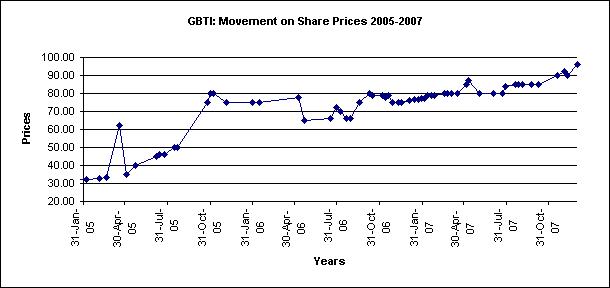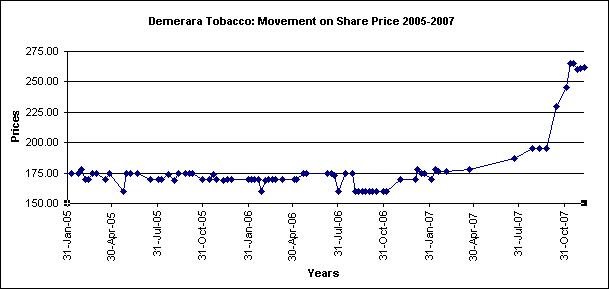Introduction
Banks DIH, the giant food and beverage company will be holding its 53rd annual general meeting on Saturday, January 17, 2009, close to four months following the end of its financial year of September 30, 2008. As a public company Banks is a reporting issuer for purposes of the Securities Industry Act, 1998 although like other domestic public companies in Guyana it is listed not on the Stock Exchange’s official list but on its Secondary List which consists of those securities that have not sought admission to the official list. Such securities are eligible for trading merely by virtue of being registered with the Guyana Securities Council.
Inclusion on the Official List on the other hand, according to the Stock Exchange website, indicates that that the, “stocks and shares that are listed are freely transferable and validly issued – not non-transferable, or forged, or otherwise tainted; it also means that the issuer meets the requirements of law and regulation in the management of its business and in the disclosure of adequate, timely and accurate information about its business to investors.” This distinction seems harsh, although companies’ silence on the reasons for their unwillingness to seek admission on the official list clearly does not help their cause.
The Barbados connection
The annual report to be put to shareholders at the meeting includes the financial statements of the company as well as the group. The group is made up of the company as the holding company, Citizens Bank Guyana Inc, a 51% subsidiary, and a dormant subsidiary Caribanks Shipping Company Limited, which appears to have little or no assets or income. The company also has two associated companies, ie companies in which it has significant influence but not control. The two such companies are BCL (Barbados) Limited and B&B Farms Inc.
BCL is owned equally by Banks Barbados, Valley Manufacturing Company Limited of Belize, Banks (DIH) Limited in Guyana and Blue Waters in Trinidad, all of whose export development needs BCL seeks to promote. Readers will recall that the Guyana-Barbados link-up was a defensive move by the local company reacting to a perceived hostile take-over about four years ago by the Trinidad conglomerate Ansa McAl. Under the deal the Barbados company was given 20% of the shares in the local company in exchange for 8.59% of the shares in the Barbados company, based on the respective book values of the shares at the time of the share exchange. Two of the directors of Banks Barbados sit on the board of Banks DIH while Mr Azam Khan represents the Guyana interest on the Barbados board.
Note 29 to the financial statements indicates that DIH purchased finished goods valued at $53 million from the Banks Holdings but made no sales to it. On the other hand sales to BCL amounted to $45 million and purchases amounted to $30 million.
Improvements
The group accounts include mainly a manufacturing entity, a financial services institution and less significantly, laundry and hotel services, a combination which does not make the group accounts easily understandable to the ordinary shareholder. While the company is separately accounted for, any member wishing to ascertain exactly how the very significant banking arm has performed would need to refer to the bank’s annual report which unfortunately is not posted on its website.
One criticism that this column has made of the company’s financial statements – that it does not include the very important statement of cash flows for the company – has been addressed and this is now contained on page 26 of the annual report. This is commendable. Also commendable is the greater level of disclosure about corporate governance although one has to wonder why an enlightened company like Banks DIH cannot have at least one female director in a board of twelve. Where is the gender-consciousness in a company of which perhaps a majority of the employees in the food division are female, as are many of its customers and shareholders?
Inadequate information
The unusually brief Chairman’s report on pages 8 and 9 of the annual report (including picture and graphs) gives very little information on the company’s operations and even in that limited space, Chairman Clifford Reis concentrates mainly on the group results with one paragraph reporting on the profits earned by the banking subsidiary and the longest paragraph dealing with the arrangement with Barbados. The annual report of the Barbados company presents a stark contrast with respect to the discussion which the management shares with its members. Significantly, in the Barbados company, the roles of Chairman and CEO are separate with both persons presenting separate reports to the members. There, the Chairman’s report runs to just two pages while that of the CEO covers more than ten. Structures and culture are different, but the amount and quality of information offered to Banks DIH shareholders is far too sparse to enable any understanding of the performance of the various divisions.
The company v the group
The table shows in the left half the performance of the company for the year ended September 30, 2008 with comparison for 2007. On the right hand side of the table are the group results ended on the same date, with H1 representing the first half of the year and H2 the second half. The first half numbers come from the unaudited half year report published under the Securities Industry Act while the second half numbers are derived from the audited financial statements.
The company’s sales for the year increased by 5.1% over 2007 to reach $13.565 billion. Profit from operations, ie before finance cost and other income including dividends received from Citizens Bank, increased by 6.4%, considerably less than the 27.12% for the group. As a percentage of sales, profit from operations increased marginally from 9.74% to 9.9% but it is not possible to determine how much of this is attributable to the company’s branded products, those it produces under licence and bought in products. After charging taxation of $570 million including a mix of property, withholding and capital gains taxes of $79 million, the company realised a net profit of $850 million (2007 – $793 million) of which dividends paid or to be paid amount to $420 million.
Profit from operations for the group increased by 27% over the preceding year to $1.922 billion with other income net of financing cost resulting in profit before tax of $1.968 billion. After taxation of $710.9 million of which property, withholding and capital gains taxes amount to $107 million, the profit for the group was $1,257 million, an increase of 22% over 2007. H1 accounted for 49% of sales but 55% of profit after tax, while in the second half of the year 51% of the sales produced only 45% of profit after tax. No explanation is given for this apparently anomalous situation but the unaudited first half would have included estimates while the second half of the year coincided with increased costs of raw material and fuel which the company may not have been able to pass on in higher prices.
Profits after tax of Citizens Bank amounted to $437.7 million, an increase of 66% over 2007. Of the amount of $437.7 million only 51% belongs to the group, the rest attributable to the shareholders who own the remaining 49% of the shares in Citizens.
The very important measure of Earnings Per Share for the group jumped by 16% from $0.90 to $1.04 but for the company the increase, which is not stated in the annual report, is a more modest 7.6% after accounting for dividends from its banking subsidiary. Perhaps this explains why the price of the company’s share was almost static throughout the year. Once again we note that there is no information or discussion on this vital factor.
Dividends
The company continues to honour a commitment it made to shareholders to pay three dividends, which of course carries an administrative cost but also allows for better cash flow management. Total dividends paid and proposed for the year are $0.45 per share compared with $0.42 per share in 2007 – an increase of 7.14%. The payout ratio which measures the share of after-tax profit paid to the shareholders was 49.41% compared with 50.44% in 2007.
The company’s balance sheet remains strong with cash resources of $1.3 billion, an increase of $1.2 billion in 2007 while net trade receivables, a function of sales and credit management increased by 24% on sales which increased by 5%. Total assets of the company grew by 5.53% while those of the group increased by 6.63%.
Outlook
Mr Reis is one of the private sector voices that can still command attention, and he was known to advocate fearlessly on behalf of his company and the private sector. At this time, his reasoned and constructive views on issues on direct and indirect taxation including VAT would have been particularly useful above the din of often uninformed rhetoric and opinion that seems dominant. The company should be leading in the advocacy for the zero-rating of bottled water (at least locally produced) – one of life’s greatest necessities and what some may even consider a public good. Water from GWI which few would want to drink without boiling is zero-rated, but that of the private producers is taxed at 16%. That policy certainly needs revisiting and offers an opportunity to the company to join with consumers to have the tax removed. This I should add is only one of several areas that need reform sooner rather than later.
Like the other commercial banks, Citizens has had a very good year and its results have embellished the group’s performance. But even banking can be cyclical and the core business of the company – particularly its beverage arm – needs to become more dynamic and be positioned to take up any downturn.
Chairman Reis in his report titled ‘Building on Traditions of Strength’ did not address the future prospects of the company. He referred briefly to the impact of the global financial crisis on remittances and the economy and expressed a commitment to be “optimistic, proactive, and to pursue a vigorous approach towards maintaining and improving the performance of the business.”
The group may need more than just commitment as the world enters the most challenging year of the company’s illustrious history.



